Bednorz W. (ed.) Advances in Greedy Algorithms
Подождите немного. Документ загружается.

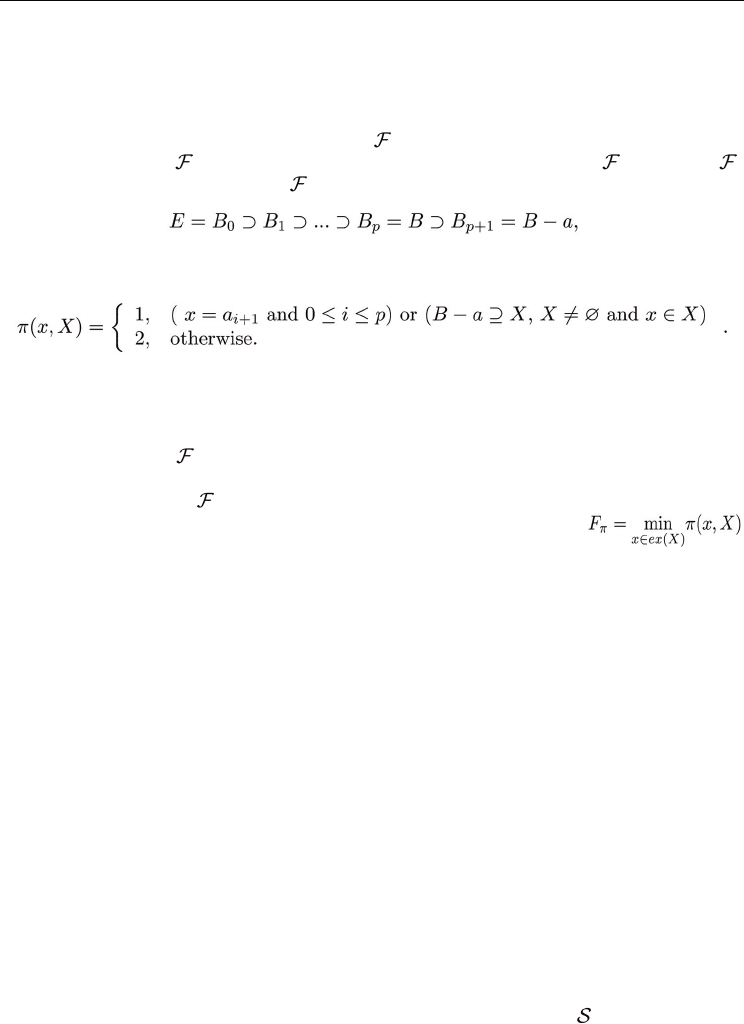
Quasi-Concave Functions and Greedy Algorithms
471
Actually, a convex geometry is the unique structure on which the Chain Algorithm
produces optimal solutions. To prove it we have to show that for each set system that is not
a convex geometry there exists a monotone linkage function for which the Chain Algorithm
does not find the ∪ − maximizer. It is obvious that if a set system is not up-accessible, then
the Chain Algorithm may not reach the optimal solution.
Now, consider an up-accessible set system (E,
) that does not satisfy the heritage property,
i.e., there exists A,B ∈
such that A ⊂ B, and there is a ∈ A such that B − a ∈ and A − a ∉ .
Up-accessibility of the set system (E,
) implies that there exists a sequence of feasible sets
where B
i
= B
i−1
− a
i
for 1 ≤ i ≤ p, and a
p+1
= a. Define a linkage function π on pairs (x,X) where
X ⊆ E, X ≠ ∅ and x ∈ X:
It is easy to verify that function π is monotone. Then the Chain Algorithm generates only
one set E, on which the value of the function F
π
is equal to 1, while F
π
(A) = 2. Thus, the Chain
Algorithm does not find a feasible set that maximizes the function F
π
. So, we have the
following theorem.
Theorem 20 Let (E,
) be an accessible and an up-accessible set system. Then the following
statements are equivalent
(1) the set system (E,
) is a convex geometry
(2) The Chain Algorithm finds a ∪ − maximizer of the quasi-concave function
for every monotone linkage function π
The Chain Algorithm is of greedy type, since it is based on the best choice principle: it
chooses on each step the extreme elements (with respect to the linkage function) and, in
such a way, approaches the optimal solution. The run-time of the algorithm depends largely
on the efficiency of linkage function computation. For instance, in Example 10 the
complexity of computing the initial linkage function values π(x, V ) for all the vertices in V is
O(|E|), where E is a set of edges. For straightforward implementation the time required for
finding the minimum value is O(|V |). After deleting the vertex with minimum value of π,
the time required for updating the linkage function values for all the neighboring vertices of
the deleted vertex is O(|V |), since the update can be carried out in time O(1) by subtracting
the corresponding weight w
ij
. So, the total time required for straightforward implementation
of the Chain Algorithm in Example 10 is O(|E| + |V |
2
) = O(|V |
2
).
In general case, the Chain Algorithm finds the ∪ − maximizer of a convex geometry (E,F) in
O(P|E|+U|E|
2
) time, where P is the maximum complexity of computing the initial linkage
function values π(x,E) over all x ∈ E, and U is the maximum complexity of updating the
linkage function values.
For some special linkage functions the running time can be improved by using more
efficient data structure that will be discussed in the next section.
4.2 Chain algorithm on join-semilattices
Now we have a monotone linkage function π, and a join-semilattice
⊆
2
E
, and we are
interested in finding a maximal maximizer of the function F
π
defined as F(X) = min
x
∈
X
π(x,X)
according to (6).
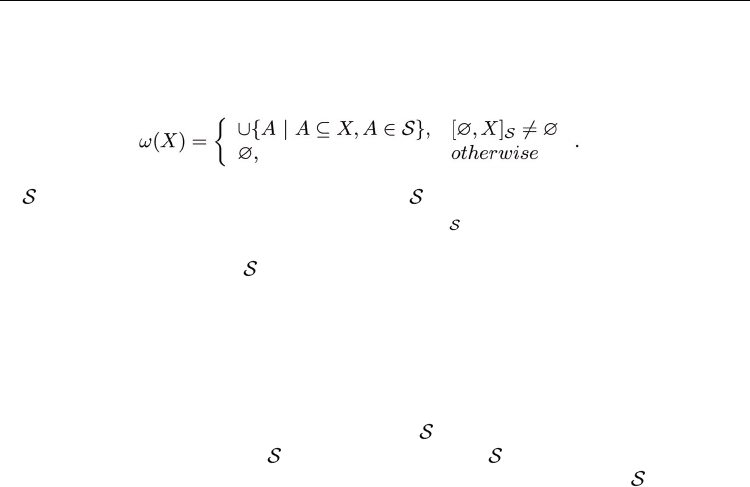
Advances in Greedy Algorithms
472
Since a join-semilattice should not to be up-accessible, we have to find another way to reach
each feasible set.
Consider the following operator:
(12)
If
is a join-semilattice, ω(X) is the largest set in contained in X (if such a set exists). In
other words, ω (X) is the 1 of the subsemilattice [∅,X]
if the subsemilattice is not empty,
and ∅, otherwise.
Note, that a join-semilattice
should not have the minimum element, and we use the
element ∅ only to complete the definition of the operator ω.
The operator ω is called interior (dual to closure) operator:
(i) ω (X) ⊆ X,
(ii) ω (X) = ω (ω (X)),
(iii ) X ⊆ Y ⇒ ω (X) ⊆ ω (Y ).
ω (X) is an interior of X. The fixed points of ω (X = ω (X)) are called the open sets of ω and
forms the dual closure system [27]. A set system (E,
) is a dual closure system if and only if
the complement set system (E,
) is a closure system. If is a join-semilattice and the
operator ω is defined by (12), then the family of open sets coincides with , excluding,
possible, the empty set.
We assume that for each X
⊆
E a procedure for finding interior ω (X) is available. Later we
will consider some examples of procedures building interior efficiently.
From quasi-concavity of function F
π
it follows that the set of maximizers is a join-semilattice
with a unique maximal element. It is easy to see that the structure of upper level semilattices
investigated for convex geometries holds for join-semilattice as well. To obtain the chain H
0
⊂ H
1
⊂ ... ⊂ H
r
= E of different 1-s we use the Chain Algorithm with the following
transformation: instead of assigning some set we replace it by its interior.
The Level-Set Algorithm-JS (u,X)
1. Set A = ω (X)
3. While A ≠ ∅ do
3.1 Set I
u
(A) = {x ∈ A : π(x,A) ≤ u}
3.2 If I
u
(A) = ∅ then stop and return A
3.3 Set A = ω (A − I
u
(A))
4. Return A.
The Chain Algorithm-JS (E, π,F)
1. Set Γ
0
= ω (E)
2. i = 0
3. While Γ
i
≠ ∅ do
3.1 u = F(Γ
i
)
3.2 Γ
i+1
= Level-Set(u, Γ
i
)
3.3 i = i + 1
4. Return the chain Γ
0
⊃ Γ
1
⊃ ... ⊃ Γ
i−1
.
Similarly with the proof of Theorem 18 we obtain the following result.
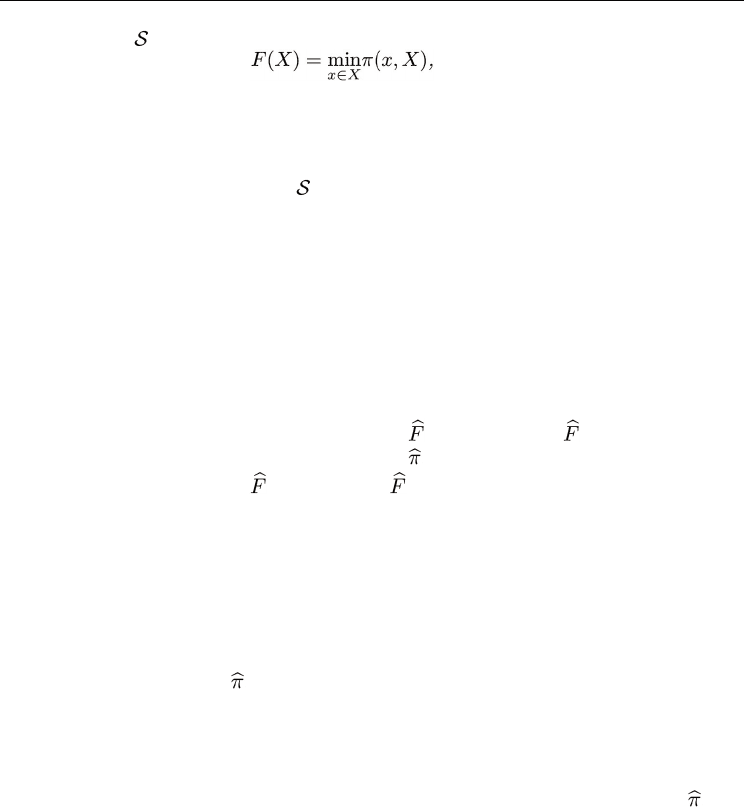
Quasi-Concave Functions and Greedy Algorithms
473
Theorem 21 Let
⊆
2
E
be a non-empty join-semilattice. Then, for every monotone linkage function
π and the corresponding function
the Chain Algorithm-JS returns the chain
Γ
0
⊃ Γ
1
⊃ ... ⊃ Γ
p
, which coincides with H
0
⊂ H
1
⊂ ... ⊂ H
r
- the chain of all different 1-s of the upper
level semilattices.
Consider the complexity of the Chain Algorithm-JS. The run-time of the algorithm depends
largely on the efficiency of interior construction. The Chain Algorithm-JS finds the ∪ −
maximizer of a join-semilattice (E,
) in O(|E|(P + T + U|E|)) time, where P is the
maximum complexity of computing the initial linkage function values π(x,E) over all x ∈ E,
U is the maximum complexity of updating the linkage function values, and T is the
maximum complexity of interior construction.
4.2.1 Algorithms for interior construction
The efficiency of the interior construction depends on the representation of a join-
semilattice. Here we consider a join-semilattice specified by a quasi-concave function. In
addition, we consider an antimatroid that is a specific case of a join-semilattice.
1. Quasi-Concave constraints. Assume that the family Ω
⊆
2
E
of feasible sets is determined
by the following constraints: for each H ∈ Ω ,
(H) >
α
, where is a quasi-concave
function defined by a monotone linkage function
. It is easy to see that the set Ω is an
α
-
level set of 2
E
, i.e., Ω = {X
⊆
E : (X) >
α
}. Since is a quasi-concave function, the set Ω is a
join-semilattice. The problem is to find interior ω(X) over Ω for every set X
⊆
E, i.e., to find 1
of the non-empty join-semilattice Ω ∩[∅,X]. Note that the Level-Set Algorithm(
α
,X) enables
us to find 1 of the non-empty join-semilattice (2
E
∩[∅,X])
α
, i.e., ω(X) over Ω. The modified
Level-Set Algorithm is as follows:
Quasi-Concave Interior Algortihm (
α
,X)
1. Set A = X
3. While A ≠ ∅ do
3.1 Set I
α
(A) = {x ∈ A : (x,A) ≤
α
}
3.2 If I
α
(A) = ∅ then stop and return A
3.3 Set A = A − I
α
(A)
4. Return A.
The Quasi-Concave Interior Algorithm finds the interior ω(X) in O(P|X|+ U|X|
2
) time,
where P is the maximum complexity of computing the initial linkage function values
(x,X)
over all x ∈ X, and U is the maximum complexity of updating the linkage function values.
2. Antimatroids. There are many equivalent axiomatizations of antimatroids, that may be
separated into two categories: antimatroids defined as set systems and antimatroids defined
as languages. An algorithmic characterization of antimatroids based on the language
definition was introduced in [6]. Another algorithmic characterization of antimatroids that
depicted them as set systems was developed in [17]. While classical examples of
antimatroids connect them with posets, chordal graphs, convex geometries, etc., game
theory gives a framework in which antimatroids are interpreted as permission structures for
coalitions [4]. There are also rich connections between antimatroids and cluster analysis [20].
In mathematical psychology, antimatroids are used to describe feasible states of knowledge
of a human learner [12].
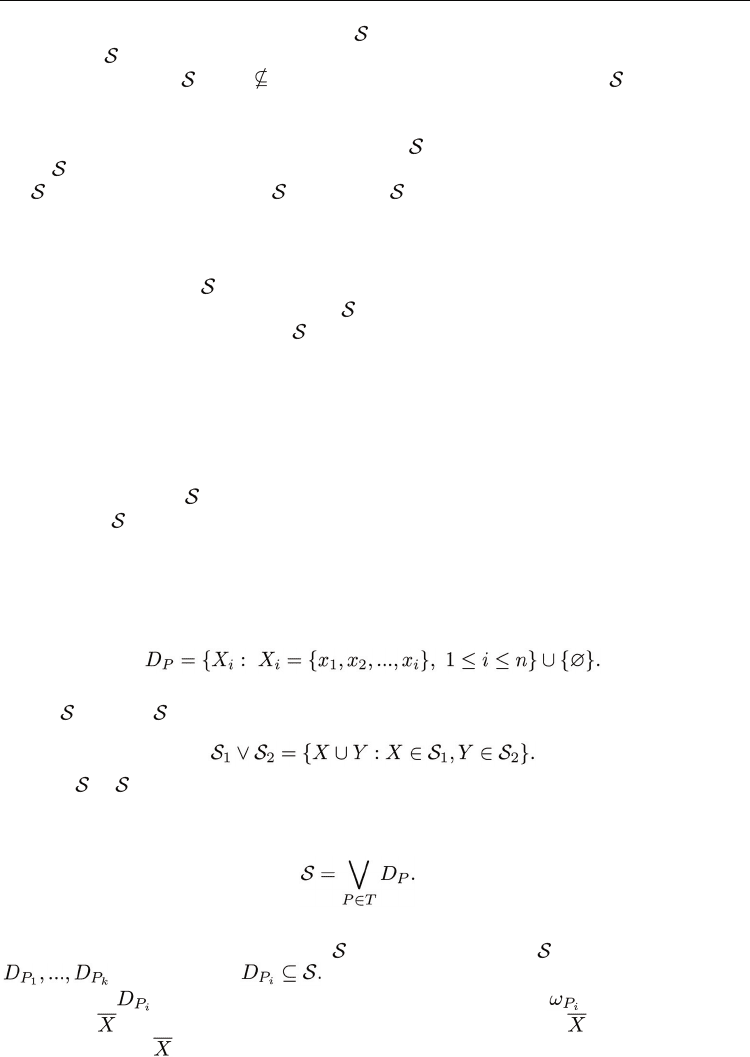
Advances in Greedy Algorithms
474
Definition 22 [16]A non-empty set system (E,
) is an antimatroid if
(A1) (E,
) is an accessible set system
(A2) for all X, Y ∈
, and X Y, there exist an x ∈ X − Y such that Y ∪ x ∈ .
It is easy to see that the chain property follows from (A2), but these properties are not
equivalent.
Proposition 23 [5][16]For an accessible set system (E,
) the following statements are equivalent:
(i) (E,
) is an antimatroid
(ii)
is closed under union (X, Y ∈ ) ⇒X ∪ Y ∈ ).
Therefore an antimatroid is a join-semilattice that includes the empty set. The interior
operator ω defined by (12) returns for each set X
⊆
E the maximal feasible subset called the
basis of X.
Since an antimatroid (E,
) satisfies the chain property, to find ω(X), one can build the chain
∅ ⊂ X
0
⊂ X
1
⊂ ... ⊂ X
m
= ω(X) belonging to .
Antimatroid Interior Algortihm(X, )
1. A = ∅
2. Find x ∈ X - A, such that A ∪ x ∈ S
if no such x exists, then stop and return A
3. Set A = A ∪ x and go to 2.
The Antimatroid Interior Algorithm returns the basis ω(X) for each set X
⊆
E that
immediately follows from the chain property.
Let an antimatroid (E,
) be given by a membership oracle which for each set A ⊆ E decides
whether A ∈
or not. Then the Antimatroid Interior Algorithm finds the interior of a set in
at most k(k + 1)/2 oracle calls, where k = |X|. Thus the complexity of interior construction is
O(|X|
2
θ), where θ is the complexity of the membership oracle.
Consider another way to define antimatroids. Let P = {x
1
< x
2
< ... < x
n
} be a linear order on E.
Define
It is easy to see that (E,D
P
) is an antimatroid.
Let (E,
1
) and (E,
2
) be two antimatroids. Define
Then (E,
1
∨
2
) is also an antimatroid [16].
Every antimatroid can be represented as a join of a family of its maximal chains. Hence, each
antimatroid may be defined by a set T of linear orders as
(13)
By analogy with convex realizers of convex geometries [10] the set T is called a realizer.
Thus, if {P
1
, P
2
, ..., P
k
} is a realizer of (E, ), then each element of is a join of elements in
. Note, that each
Since each (E,
) is an antimatroid , there are k interior operators , where ω
P
(X) = {y ∈
E : y ≤
P
min }, i.e., let P = {x
1
< x
2
< ... < x
n
} and a minimal element of with respect to the
order P be x
i
= min , then ω
P
(X) = {x
1
, x
2
, ..., x
i−1
}.
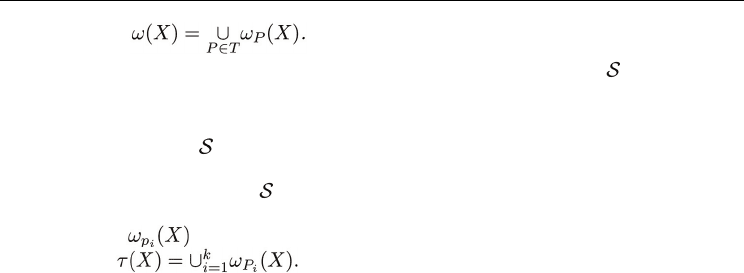
Quasi-Concave Functions and Greedy Algorithms
475
Proposition 24
Proof. Let A = ∪
P
∈
T
ω
P
(X). Since for each P ∈ T, ω
P
(X)
⊆
X and ω
P
(X) ∈ , then ω
P
(X)
⊆
ω(X), which implies A
⊆
ω(X). Conversely, from (13) ω(X) = ∪
P
∈
T
X
P
, where X
P
∈ D
P
. Since
ω(X)
⊆
X implies X
P
⊆
X for all P ∈ T, then X
P
⊆
ω
P
(X) and so ω(X)
⊆
A. ■
Let an antimatroid (E,
) be given by a realizer T = {P
1
, P
2
, ..., P
k
}, then the following
algorithm builds the interior set using Proposition 24.
Ordering Interior Algorithm(X,
)
1. For i = 1 to k do
1.1 build
2. Return
A straightforward implementation of the Ordering Interior Algorithm runs in O(k|E|),
where k is the cardinality of a realizer.
5. Ortholog clustering
This section deals with applications of quasi-concave functions to clustering in
bioinformatics. We concentrate on the one of the problem of comparative genomics.
Comparative genomics is a field of biological research in which the genome sequences of
different species are compared. Although living creatures look and behave in many
different ways, all of their genomes consist of DNA, the chemical chain that includes the
genes that code for thousands of different kinds of proteins. Thus, by comparing the
sequence of the human genome with genomes of other organisms, researchers can identify
regions of similarity and difference. This information can help scientists better understand
the structure and function of human genes and thereby develop new strategies to combat
human disease. Comparative genomics also provides a powerful tool for studying
evolutionary changes among organisms.
A fundamental problem in comparative genomics is the detection of genes from different
organisms that are involved in similar biological functions. This requires identification of
homologous genes that are similar to each other because they originated from a common
ancestor. Such genes are called orthologs [13].
We describe an ortholog clustering method where we require that any sequence in an ortholog
cluster has to be similar to other sequence from other genomes in that ortholog cluster.
5.1 Ortholog detection using multipartite graph clustering
The input for the ortholog clustering problem is a set of genetic sequences along with
information about the organisms they belong to. The goal is to find similar sequences from
different organisms. The ortholog detection problem is complicated due to the presence of
another type of very similar sequences in the same organism. These sequences, called
paralogs, are result of duplication events when a gene in an organism is duplicated to occupy
two different positions in the same genome. Although both types of genes are similar, only
orthologs are likely to be involved in the same biological role. So, for detecting orthologs it is
critical to focus on the similarities between genes from different organisms while ignoring
the similarities between genes within an organism.
The requirement of selectively ignoring gene similarities for paralogous sequences can be
conveniently represented in a multipartite graph. A graph is a multipartite if the set of
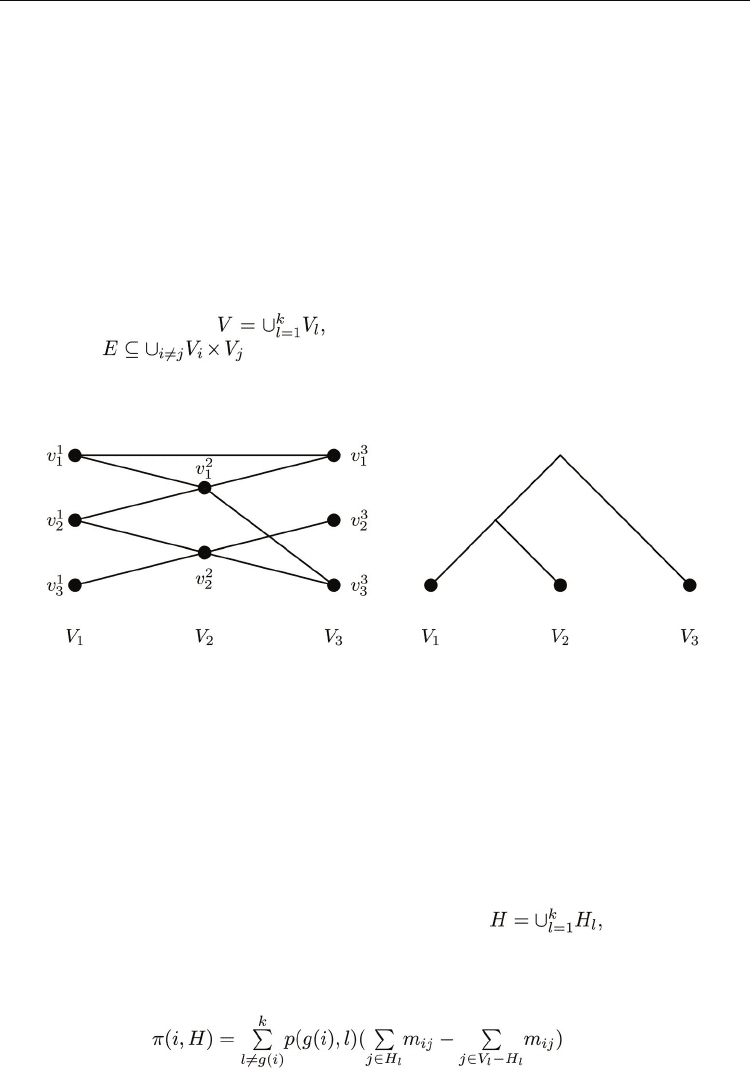
Advances in Greedy Algorithms
476
vertices in the graph may be divided into non-empty disjoint subsets, called parts, such that
no two vertices in the same part have an edge connecting them. We use a multipartite
graph, where different genomes correspond to different parts and the genes in a genome
correspond to vertices in a part.
Another specific problem in finding ortholog clusters is that orthologous genes from closely
related organisms will be much more similar than those from distantly related organisms.
Fortunately, we often have estimates of evolutionary relationships between the organisms
that define a hierarchical graph over the partite sets. Using this evolutionary graph, called a
phylogenetic tree, we can correct the observed gene similarities by scaling up the similarities
between the orthologs from distantly related organisms.
Consider the ortholog clustering problem with k different genomes, where the genome l,
represented by V
l
(l = 1, 2, ...k), contains n
l
genes. Then, the similarity relationships between
genes from different genomes can be represented by an undirected weighted multipartite
graph G = (V,E,W), where
, every set V
l
contains n
l
vertices corresponding to n
l
genes, and (i, j = 1, 2, ..., k) is a set of weighted edges representing
similarities between genes. The example of a multipartite graph is illustrated in Figure 3 (a).
The relationship between these genomes is given by the phylogenetic tree relating the
species under study (see Figure 3 (b)).
(a) (b)
Fig. 3. Multipartite graph (a) and phylogenetic tree (b).
We consider an ortholog cluster as a largest subgraph with the highest density. For finding
an ortholog cluster we assign a score F(H) to any subset H of V. A score function F denotes a
measure of proximity among genes in H. Then an ortholog cluster H* is defined as the
subset with the largest score value (a maximizer of F). To build a score function F(H) we use
Definition 6 that is based on using a linkage function π(i,H) which measures the degree of
similarity of the gene i ∈ H to other genes in H.
Our linkage function considers the sequence similarity between genes within the ortholog
cluster, their relationship to genes outside the cluster, and the phylogenetic distance
between the corresponding genomes.
We require that H contains at least two genomes. So, let
, where
H
l
is the
subset of genes from V
l
present in H. If m
ij
≥ 0 is the similarity value
between gene i from
genome g(i) and gene j from another genome g(j), and
p(g(i), g(j)) represents the distance
between the two genomes, then the linkage function is defined as
(14)
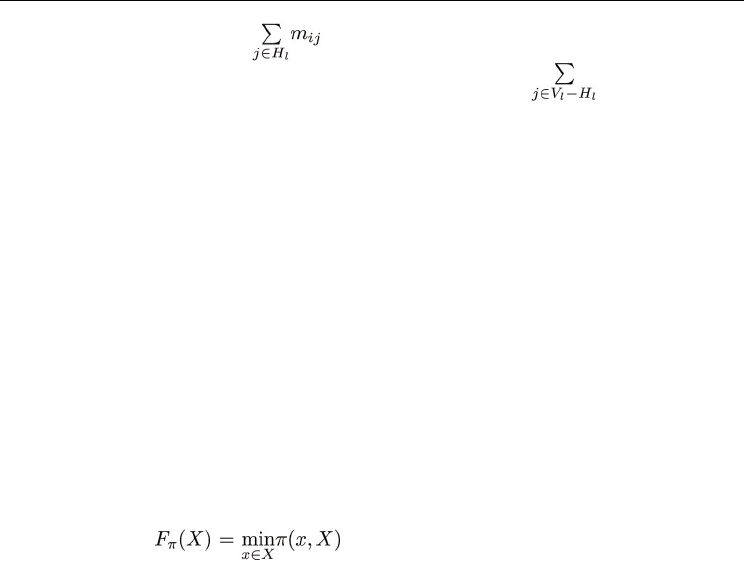
Quasi-Concave Functions and Greedy Algorithms
477
For each part V
l
≠ g(i) the term
aggregates the similarity values between the genes i
and all other genes in the subset H
l
, while the second term, m
ij
, estimates the
relationship between gene i and genes from genome l that are not included in H
l
. A large
positive difference between two terms ensures that the gene i is highly similar to genes in H
l
and at the same time very dissimilar from the genes not included in H
l
. From a clustering
point of view, this ensures large values of intra-cluster homogeneity and inter-cluster
separability for extracted cluster.
The scaling term p(g(i),l) is used for correcting the observed sequence similarities by
magnifying the sequence similarities corresponding to genomes which diverged in ancient
times. Given the phylogenetic tree relating the species under study, the distance p(g(i), g(j))
between genomes g(i) and g(j) is defined as the height, h
g(i),g(j)
, of the subtree rooted at the
last common ancestor of these genomes. When the species are closely related, a function that
depends on h
g(i),g(j)
, but grows slower will better model the distance between the species.
Choosing an appropriately growing function is critical because a faster growing function
will have the undesirable effect of clustering together sequence from distance species but
leaving out the sequence from closely related species. So, in this case the distance p(g(i), g(j))
may be defined as (1 + log
2
h
g(i),g(j)
).
It is easy to verify that function π defined in (14) is monotone. Firstly note that the distance
p(g(i), g(j)) ≥ 0 has no effect on the monotonicity. Consider the case when H is extended by
some gene p. If i ∈ g(p), then π(i,H ∪ p) = π(i,H), otherwise π(i,H ∪ p) − π(i,H) = 2p(g(i),
g(p))m
ip
≥ 0
So, the function is quasi-concave and we can use the Chain
Algorithm to find the orthogonal cluster.
5.2 Analysis and implementation
The performance of the Chain Algorithm depends on the type of data structure one chooses
to maintain the set of linkage function values. In Example 10 the total time required for
straightforward implementation of the Chain Algorithm is O(|V |
2
). Here we build the
efficient data structure that enables us to reduce the run-time of the algorithm. There are
three operation that are performed at each iteration of the algorithm.
i. find-min - this operation performs in Step 3.1 of the Chain Algorithm where the value
F(Γ
i
) is determined.
ii. delete-min - this operation performs in Step 3.2 of the Chain Algorithm when the Level-
Set Algorithm finds set I
u
(A) of elements with the minimum value of function π and
removes this set from the set A.
iii. decrease-key - this operation performs inside the Level-Set Algorithm. Deleting set I
u
(A)
entails updating the linkage function values for all neighbors of elements from this set.
If |V | elements are organized into a Fibonacci heap [14], we can perform a delete-min
operation in O(log V ) amortized time and a decrease-key operation in O(1) amortized time,
while a find-min operation can be done in constant time [8].
Proposition 25 [33] With a Fibonacci heap, the Chain Algorithm finds an ortholog cluster in time
O(|E| + |V | log |V |).
Proof. The initialization of the algorithm includes computing π(i, V ) for each i ∈ V. The
value π(i, V) depends on the weights on edges incident to i and on the relationship of the

Advances in Greedy Algorithms
478
genome g(i) with other genomes. We assume that the number of genomes is very small
compared to the number of genes, i.e., k << n. Thus computing the initial linkage function
values for all the vertices takes O(|E|).
We use Fibonacci heap to store vertices according to their linkage function values. So, the
value F(Γ
i
) can be found in O(1) time, and since each deletemin operation takes O(log V )
amortized time, the total time for all calls to delete-min is O(V log V ).
Each deleting of an element with minimum value of linkage function π leads to updating the
linkage function values for all neighbours of the element. Due to the additive property of the
linkage function (14), the update can be carried out in time O(1) by subtracting the
corresponding value 2p(g(i), g(p))m
ip
due to the deleted edge (i, p).
Decreasing the value of function π involves an implicit decrease-key operation, which can be
implemented in O(1) amortized time. As each edge is deleted once, all linkage function
updates together require O(|E|) time. Thus, the algorithm runs in O(|E| + |V | log |V |)
time. ■
The proposed ortholog clustering method was applied to the protein sequences from
complete genomes of seven eukaryotes present in the eukaryotic orthologous groups [33].
The analysis of these results shows that clusters obtained using proposed method show a
high degree of correlation with the manually curated ortholog clusters.
6. Conclusions
In this article, we have investigated monotone linkage functions defined on convex
geometries, antimatroids, and semilattices in general. It has been shown that the class of
functions defined as minimum values of monotone linkage functions has close relationship
with the class of quasi-concave set functions. Quasi-concave functions defined on
semilattices, antimatroids and convex geometries determine special substructures of these
set families. This structures allow building efficient algorithms that find minimal sets on
which values of quasi-concave functions are maximum.
The mutual critical step of these algorithms is how to describe the set closure operator. If an
efficient algorithm of the closure construction exists it causes the optimization algorithm to
be efficient as well. On the other hand, we think that the closure construction problem is
interesting enough to be investigated separately. Thus, we suppose that for an arbitrary
semilattice the problem of closure construction has exponential complexity.
An interesting direction for future work is to develop our methods for relational databases,
where a polynomial algorithm for closure construction is known [3].
We have considered some applications of quasi-concave functions to clustering a structured
data set, where together with pair-wise similarities between objects, we are also given
additional information about objects organization.
We focused on a simple structure - a partition model of data where the objects are a priori
partitioned into groups. While clustering such data, we also considered an additional
requirement of being able to differentiate between pairwise similarities across different
partite sets. Existing clustering methods do not solve this problem, since they are limited to
finding clusters in a collection of isolated objects.
The requirement of differentially treating pair-wise relationships across different groups
was modeled by a multipartite graph along with a hierarchical relationship between these
groups. The problem was reduced to finding the cluster (subgraph) of the highest density in
the multipartite graph.

Quasi-Concave Functions and Greedy Algorithms
479
This problem is usually formulated as finding the maximum weight multipartite clique.
However, no efficient procedure exists for solving this problem. Due to this, clusters are
often modeled as quasi-cliques or dense graphs.
Traditionally, quasi-cliques are defined, using a threshold, as a relaxation of a complete
subgraph - the relaxation can be on the degree of a vertex or on the total number of edges in
the quasi-clique. In contrast to traditional quasi-clique definition, our definition does not use
any threshold parameters.
The proposed multipartite graph clustering method was successfully applied to the ortholog
clustering problem. It may be also adapted to other clustering problem both in comparative
genomics and in computer vision [35].
7. References
[1] Bagotskaya, N.V.; Levit, V.E. & Losev, I.S. (1988). On one generalization of matroids
insuring applicability of dynamic programming method, In: Information
Transmission and Processing Systems, Vol. 2, IPIT USSR Academy of Sciences,
Moscow, (33–36). (in Russian)
[2] Bagotskaya, N.V.; Levit, V.E. & Losev, I.S. (1990). A combinatorial structure insuring
applicability of dynamic programming method, Automation and Remote Control 50,
(1414-1420).
[3] Beeri,C. & Bernstein, P.A. (1979). Computational problems related to the design of
normal form relational schemes, ACM Transactions on Database Systems 4, No.1, (30-
59).
[4] Bilbao, J.M. (2003). Cooperative games under augmenting systems, SIAM Journal of
Discrete Mathematics 17, (122-133).
[5] Björner, A. & Ziegler, G.M. (1992). Introduction to greedoids, In: Matroid applications, ed.
N. White, Cambridge Univ.Press, Cambridge, UK.
[6] Boyd, E.A. & Faigle, U. (1990). An algorithmic characterization of antimatroids, Discrete
Applied Mathematics 28, (197-205).
[7] Chernoff, H. (1954). Rational selection of decision functions, Economica 22, (422-443).
[8] Cormen, T.H.; Leiserson, C. E.; Rivest, R. L. & Stein, C. (2001). Introduction to Algorithms,
second ed. MIT Press and McGraw-Hill, (476-497).
[9] Edelman, P.H. & Jamison, R.E. (1985). The theory of convex geometries, Geom. Dedicata
19, (247-270).
[10] Edelman, P.H. & Saks, M.E. (1988). Combinatorial representation and convex dimension
of convex geometries, Order 5, No.1, (23-32).
[11] Edmonds, J. (1971). Matroid and the greedy algorithm, Mathematical Programming 1,
(127-136).
[12] Eppstein, D. (2008). Upright-Quad Drawing of st-planar learning spaces, Journal of
Graph Algorithms and Applications 12, No. 1, (51-72).
[13] Fitch, W.M. (1970). Distinguishing homologous from analogous proteins, Systematic
Zoology 19, (99-113).
[14] Fredman, M.L. & Tarjan, R.E. (1987). Fibonacci heaps and their uses in improved
network optimization algorithms, Journal of the ACM 34, No.3, (596-615).
[15] Goecke, O. (1988). A greedy algorithm for hereditary set systems and a generalization of
the Rado-Edmonds characterization of matroids, Discrete Applied mathematics 20,
(39-49).

Advances in Greedy Algorithms
480
[16] Korte, B.; Lovász, L. & Schrader, R. (1991). Greedoids, Springer-Verlag, New
York/Berlin.
[17] Kempner, Y. & Levit, V.E. (2003). Correspondence between two antimatroid algorithmic
characterizations, The Electronic Journal of Combinatorics 10, R44.
[18] Kempner, Y. & Levit, V.E. (2008). Duality between quasi-concave functions and
monotone linkage functions, arXiv:0808.3244 [math.CO].
[19] Kempner, Y.; Mirkin, B. & Muchnik, I. (1997). Monotone linkage clustering and quasi-
concave functions, Appl.Math.Lett. 10, No.4 (19-24).
[20] Kempner, Y. & Muchnik, I. (2003). Clustering on antimatroids and convex geometries,
WSEAS Transactions on Mathematics 2, Issue 1, (54-59).
[21] Kempner, Y. & Muchnik, I. (2008). Quasi-concave functions on meet-semilattices,
Discrete Applied Mathematics 156, No. 4, (492-499).
[22] Kuusik, R. & Lind, G. (2004). Generator of Hypotheses - An approach of data mining
based on monotone system theory, International Journal of Computational Intellegence
1, No. 1, (43-47).
[23] Malishevski, A. (1998). Properties of ordinal set functions, In: A.Malishevski, Qualitative
Models in the Theory of Complex Systems, Nauka, Moscow, (169-173) (in Russian).
[24] Mirkin, B. & Muchnik, I. (2002). Layered clusters of tightness set functions, Appl. Math.
Lett. 15, (147-151).
[25] Mirkin, B. & Muchnik, I. (2002). Induced layered clusters, Hereditary Mappings, and
Convex Geometry, Appl. Math. Lett. 15, (293-298).
[26] Monjardet, B. & Raderanirina, V. (2001). The duality between the antiexchange closure
operators and the path independent choice operators on a finite set, Mathematical
Social Sciences 41, (131-150).
[27] Monjardet, B. (2003). The presence of lattice theory in discrete problems of mathematical
social sciences. Why. Mathematical Social Sciences 46, (103-144).
[28] Muchnik, I. & Shvartser, L.V. (1989). Kernels of Monotonic Systems on a Semi-lattice of
Sets, Automation and Remote Control 50, No. 8, part 2, (1095-1102).
[29] Mullat, J. (1976). Extremal subsystems of monotone systems: I, II, Automation and Remote
Control 37, (758-766); (1286-1294).
[30] Mullat, J. (1995). A fast algorithm for finding matching responses in survey data table,
Mathematical Social Sciences 30, (195-205).
[31] Sen, A.K. (1971). Choice functions and revealed preference, Review of Economic Studies
38, (307-317).
[32] Serganova, V.V.; Bagotskaya, N.V.; Levit, V.E. & Losev, I.S. (1988). Greedoids and the
greedy algorithm, In: Information Transmission and Processing Systems, Vol. 2, IPIT
USSR Academy of Sciences, Moscow, (49-52). (in Russian)
[33] Vashist, A.; Kulikowski, C.A. & Muchnik, I. (2007). Ortholog clustering on a
multipartite graph, IEEE/ACM Transactions on Computational Biology and
Bioinformatics 4, No. 1 (17-27).
[34] Zaks (Kempner), Y. & Muchnik, I. (1989). Incomplete classifications of a finite set of
objects using monotone systems,
Automation and Remote Control 50, (553-560).
[35] Zhang, R.; Vashist, A.; Muchnik, I.; Kulikowski, C. A. & Metaxas, D. N. (2005). A new
combinatorial approach to supervised learning : Application to gait recognition,
LNCS 3723 (55-69).
